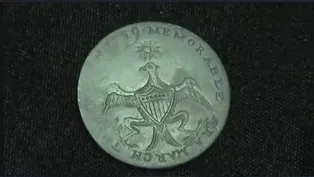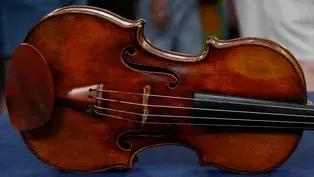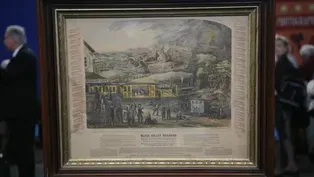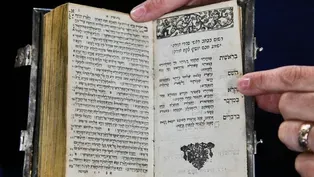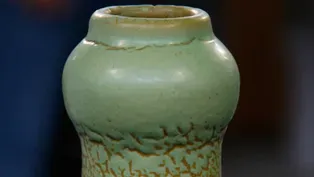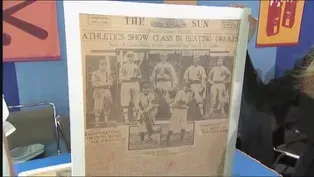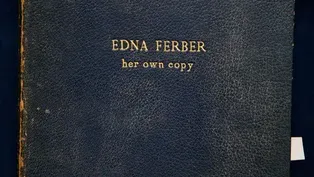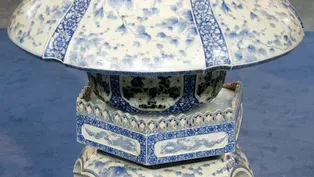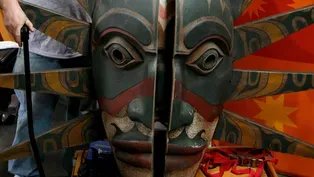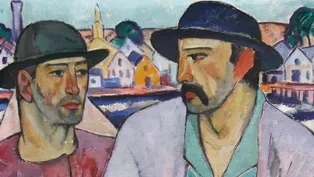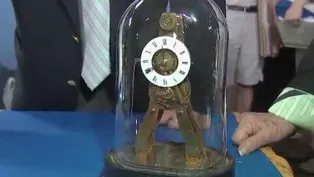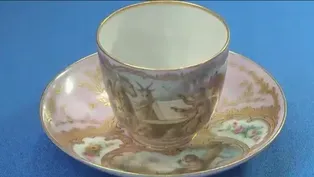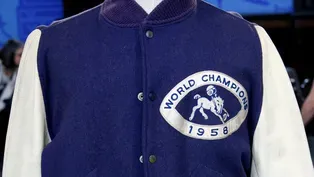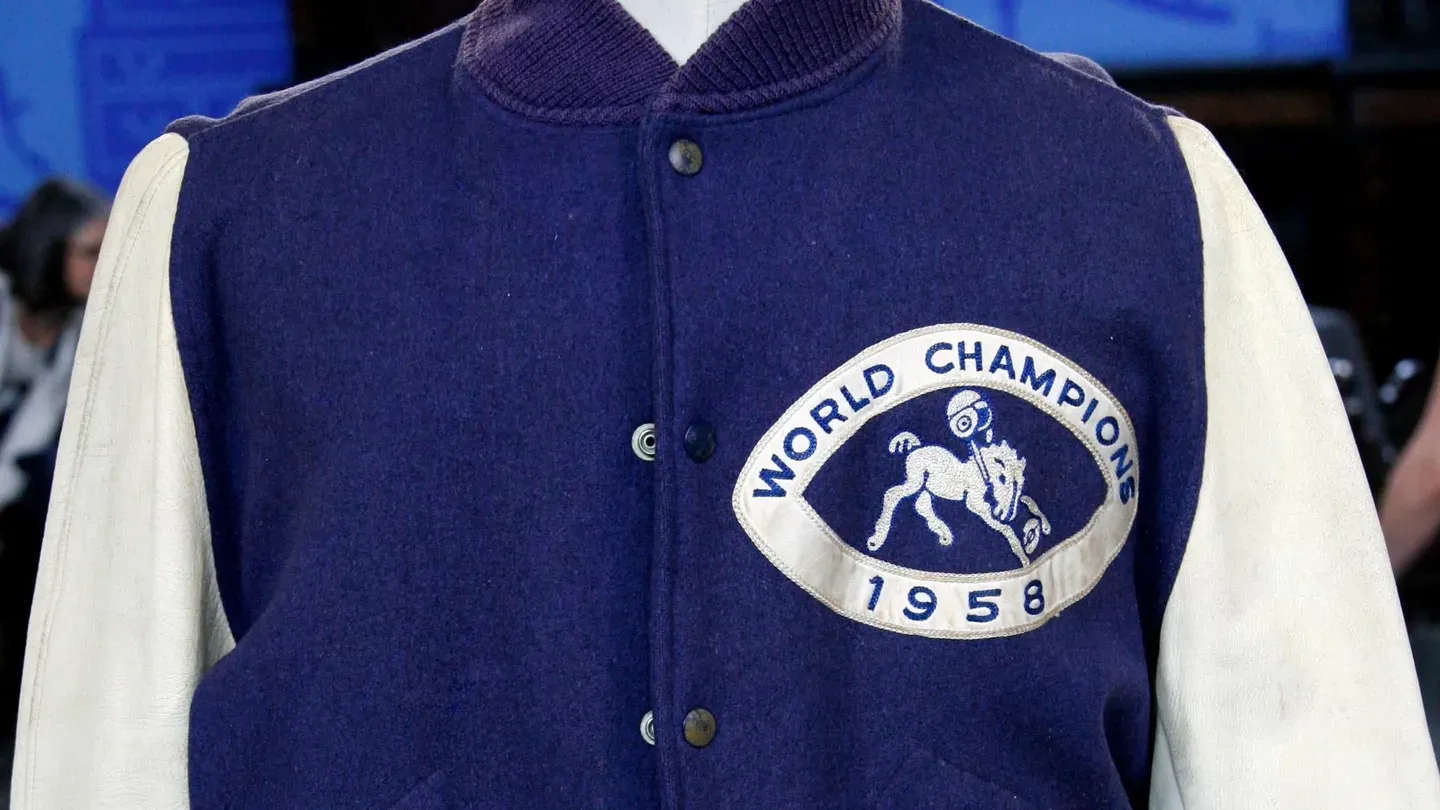

Vintage Baltimore 2021, Hour 2
Season 25 Episode 3 | 52m 45sVideo has Closed Captions
What are treasures from the 2007 Baltimore ROADSHOW worth now?
What are treasures from the 2007 ROADSHOW in Baltimore worth now? Appraisals include a Johnny Unitas Baltimore Colts championship jacket, a B. J. O. Nordfeldt two-sided oil, and a Klondike Gold Rush archive. One has more than doubled to $250,000!
Problems with Closed Captions? Closed Captioning Feedback
Problems with Closed Captions? Closed Captioning Feedback
Funding for ANTIQUES ROADSHOW is provided by Ancestry and American Cruise Lines. Additional funding is provided by public television viewers.

Vintage Baltimore 2021, Hour 2
Season 25 Episode 3 | 52m 45sVideo has Closed Captions
What are treasures from the 2007 ROADSHOW in Baltimore worth now? Appraisals include a Johnny Unitas Baltimore Colts championship jacket, a B. J. O. Nordfeldt two-sided oil, and a Klondike Gold Rush archive. One has more than doubled to $250,000!
Problems with Closed Captions? Closed Captioning Feedback
How to Watch Antiques Roadshow
Antiques Roadshow is available to stream on pbs.org and the free PBS App, available on iPhone, Apple TV, Android TV, Android smartphones, Amazon Fire TV, Amazon Fire Tablet, Roku, Samsung Smart TV, and Vizio.
Buy Now

ANTIQUES ROADSHOW 2025 Tour!
Enter now for a chance to win free tickets to ANTIQUES ROADSHOW's 2025 Tour! Plus, see which cities we're headed to!Providing Support for PBS.org
Learn Moreabout PBS online sponsorship♪ ♪ When you pulled the jacket out, I saw it.
I was, like, "Wow, that's a championship jacket."
How great is that?
When you showed me Johnny Unitas's name... MAN: That's even better.
(laughs): I almost fell on the floor.
It's amazing.
I can't wait to tell my husband.
(laughs) ♪ ♪ CORAL PEÑA: In 2007, "Roadshow" returned to Charm City, Baltimore, Maryland, where people from all across the Mid-Atlantic lined up to charm our appraisers with their family stories and flea market finds.
MAN: It was given to me by my father.
I got a pair of Rollerblades and this, and at the time, I was a lot more excited about the Rollerblades.
I kind of saw it and I bought it.
I scoffed it up right away, because... (laughs) You don't see this kind of thing too, too often here in the East, anyway.
No, it's unusual.
PEÑA: Have the objects we discovered kept or lost their charm in 14 years?
Find out in this second hour of "Vintage Baltimore."
WOMAN: I got it about 22 years ago, and I got it basically because it was a snow scene.
I bought it in a thrift store, and it was $125, which seemed like a whole lot of money at the time.
APPRAISER: Yeah.
And I even waited a week to buy it.
And then the lady who ran the thrift store was nice enough to hold it for me for another week until my husband got paid.
And I love it because of the snow, and I just wanted more information about it.
Well, you know the artist.
I knew the artist.
I looked it up before I bought it.
Walter Launt Palmer.
Mm-hmm.
Yeah, it's Walter Launt Palmer.
He was a 19th-century artist.
Do you know anything more about him at all?
His father was a sculptor, and other than that... Yeah.
Well, he was, he was a 19th-century artist trained as a Hudson River School artist.
He was born in 1854 and lived to 1932.
It was painted probably around 1900.
He did almost exclusively these snow scenes, and he was very popular during his day.
And he's able to capture the tones of the sunset, the beautiful light coming through the trees.
He sort of went out of favor, but he's coming back in these days.
One thing about this painting, though, which is very evident, is the fact it's under glass.
Did, did you put it under the glass at all?
No, it was under glass when I purchased it, and the paper on the back mentioned that it... over fireplace in library, and I just figured somebody put glass on it to protect it... Yeah.
...from soot or something.
Right.
Well, these days, we generally practice... Is to not have paintings under glass, but the ones that have been under glass have been protected.
We don't like it to a certain extent, because there's a, sometimes a micro climate that happens under there, that they tend to bake a little bit underneath there.
But it's saved many paintings from a mop handle going through it, or a tennis ball being thrown at it by the kids.
Or as you say, the soot from a fireplace or nicotine smoke, things like that.
So what we have here is a really good-condition Walter Launt Palmer.
Oh, good!
You can see up in here this impasto, and it's very distinctive.
You can see the brushstrokes up in there, beautiful light coming through, the sun and the trees, and then also down here, we love the pinks and the lavenders, you know, all these colors he's brought out of white snow.
I would recommend at some point having it reframed and a, and a light cleaning.
Was this the original frame?
Most likely not, but it's probably been in there for at least 50 years.
So it's a terrific example of his work, and it's been preserved very well because of the glass.
If you brought this to me about three years ago, I would have said $20,000 to $30,000.
Uh-huh.
But he's recently spiked.
And some of my colleagues...
Right now, at auction, I'd put an estimate of $50,000 to $70,000.
Oh, no!
(laughs) Absolutely.
Oh, my.
(giggling): Oh!
(laughing) How much...
I'm serious, how much did you say?
$50,000 to $70,000.
50 to 70... Oh!
(laughing) I can't wait to tell my husband!
(chuckles) (laughing) Oh, my.
(laughing): Oh.
(laughing) Ooh!
Now, you be careful with it on the way home, now.
Oh, he's driving.
He's driving.
It's okay.
Oh!
MAN: I got this thing in Maryland from a dealer about nine years ago, and he said that he had gotten it from the estate of a missionary up in the Lehigh Valley of Pennsylvania about nine years before that, so I guess he had bought it around 1980, somewhere around that range.
APPRAISER: 1980, and did you buy it on the spot, or did you look at it for a while?
Uh, I kind of saw it and I bought it.
I scoffed it up right away, because... (laughs) You don't see this kind of thing too, too often, here in the East, anyway.
No, it's unusual.
Soon after I purchased it, I had it appraised back in '99, I believe.
She thought it was probably Kwakiutl, Northwest Coast, probably Vancouver Island-- right in that-- and dated it somewhere probably 1900 to 1910.
Valued it at, like, $8,000 auction value.
Okay, now, was there anything that she said to you that made you suspicious?
Mm, no, she, she didn't seem to have any, you know, any issues with it.
Okay, when you looked at transformation masks, were they like this?
I've never seen anything this big.
All right.
Yeah.
We know it was a transformation mask.
It's in the style of Kwakiutl, from the Northwest Coast, British Columbia.
Mm-hmm.
It's a dance mask.
Now, it took two people to lift this up on the table.
Right.
So nobody could dance with this thing.
Right.
That's where you should have really gotten suspicious.
Mm-hmm.
Because this thing is way too heavy and way too big to be a ceremonial dance mask that a man would have worn on his face.
And during the course of the dance, he would have opened it up, and it would have articulated...
Right.
And it would have been very dramatic.
As you can see, with any transformation mask, when you close it, you get a completely different look, which is what the transformation is all about.
Mm-hmm.
And you see, again, you know, this very broad nose, these full lips-- not exactly, stylistically, what we want to see in a traditional Kwakiutl transformation mask.
Okay.
And then we could go into further things like, if we wanted to, we could test the paint.
Uh-huh.
You'll notice, back here, we have hinges.
Mm-hmm.
We could go in, we could look carefully at those hinges, and all of this would give us information.
Mm-hmm.
But we have some serious red flags now.
I think it was made in Indonesia, and it was made for this marketplace, and it was made for the decorative market.
Okay.
Now, you paid...
He was asking $5,000.
I talked him down quite a bit from there, um, so, you know...
In the $3,000 to $4,000 range, or...?
Yeah, yeah.
Okay.
This is a very dramatic piece.
You saw the buzz in the hall.
They love this kind of thing.
Mm-hmm.
Unfortunately, in most showrooms, I think you're going to see a little bit less than you paid for.
Yeah.
I think it's going to be more in the $1,500 to $2,500 range.
I think it's very salable.
I think it's dramatic.
I think it's a terrific piece... Mm-hmm.
But it's just not exactly what you thought.
Okay.
MAN: It was a gift to me on my bar mitzvah.
It was actually given to me by my father.
I got a pair of Rollerblades and this, and, at the time, I was a lot more excited about the Rollerblades.
But I do know that it was given to my father from one of his cousins, who he considered an uncle, and to him from another family member.
It's a copy of the five books of Moses-- the Torah, the Hebrew Bible.
Right.
So something that would have been used as a scholarly work.
What's interesting about it is, it has a silver binding overlaid on brass.
Yeah.
And this little cartouche here on the cover would have been so that you could have it monogrammed or engraved.
This kind of thing would have been given as a gift for a significant occasion.
And the book itself was printed in Amsterdam, dated 1722.
So, it's a very early piece.
You know, Judaica, sort of Jewish ceremonial items, as you know, is pretty rare.
There weren't a lot to begin with, and the fact that it survived all these centuries intact is a pretty amazing thing.
It's very elaborately and richly decorated.
And if you put into the context of history, Amsterdam was a very important center for commerce and trade in the 18th century, and the Jewish population was certainly large and very prominent in the merchant and shipping trades.
So it's the kind of thing that would have certainly have been presented at that time to somebody of means.
It has a few condition issues, which impact it a bit.
On the front, it's missing a little bit of the decoration in the binding, and it would have had another title page-- an engraved and decorated title page.
Okay.
And that's not the end of the world.
What collectors will often do is find a copy of a similar work and get a reproduction of the title page and have it tipped into the book so that it's complete.
It's something that is quite rare.
And, I would think, for insurance purposes, you'd probably want to look in the $8,000 to $10,000 range.
Oh, wow.
So, a little better than the Rollerblades, in retrospect.
Yeah, I guess so, huh?
This is a thrift shop find?
Yep, paid two dollars for it.
Two dollars?
You go to thrift shops a lot?
Yeah.
Yeah?
Well, do you know what this is?
I have no idea.
No idea?
It's a great, great piece, it's by Tiffany Studios.
It's a lamp base.
If this was in an auction, it would bring between $3,000 and $5,000.
No kidding!
Yeah.
Holy mackerel.
WOMAN: I was walking through a neighbor's house.
She was showing me all her treasures, and it was hanging on a lamp shade.
And, like, ten years later, when she had passed away, I was given all the leftovers to save something.
It was originally a pendant.
It wasn't meant to be on a lamp.
It's by Georges Pierre of France.
It's clarified and tinted horn, and very collectible.
Well, it dates to around 1900, turn-of-the-century Art Nouveau.
My husband and I were traveling in Greece around 1969 to 1970, and he saw this and fell in love with it and bought it.
And I liked it, too.
Well, this is what's called a miniature skeleton clock, and the origin is French.
It's made shortly after 1850 by Victor Pierret.
This particular one is in really wonderful condition.
It has its original base and its original dome.
The coloring on the brass is just absolutely in first-rate condition.
And you may have noticed that the dial is porcelain.
Yes, I noticed that.
Porcelain dials never fade, and always keep a really crisp coloring to them.
Oh, Lord, wow.
Yeah.
Do you remember what you paid for it or have any idea what the value is?
I think, yes-- I think... No, I don't have no idea of the value.
I think that it, we paid around $50.
Mm-hmm.
But last night, I was asking my son if I should bring this, and he said, "I don't believe that'd be worth it.
You better find something else."
But I decided I loved it.
So that's why I decided to bring it.
Well, it was a good choice.
This would be a clock that could easily sell in a shop for about $2,500.
$2,500, my heavens.
$2,500.
(laughs) That's making a lot of money after spending $50.
It is, isn't it?
(laughing): It's great.
Well worth the investment.
Absolutely.
MAN: This is John Unitas's jacket.
He was a friend of the family's.
He would come over to our house when we lived in Towson.
I was about ten, 11 years old at the time.
And of course, all my friends would come over.
They'd all bring their football.
John would just be standing around looking at us.
And he was, like, six-two, something like that.
He'd take the ball and start padding like this, and acting like he was going to throw it.
(laughs) And we were just standing there looking at him.
You know.
It's like the dream come true, you know?
It was, and got to know him through the years.
Great guy, he had a great sense of humor.
He exuded confidence at all time.
He's an icon.
Probably the most important person in pro football history, or one of them, certainly.
The Colts, of course, won, as you said, in sudden-death overtime, 23-17, versus the New York Giants.
They won the championship.
They also won it the next year, 1959.
They did.
Two in a row.
And this, as you said, is Johnny U's jacket.
Here we have this wonderful patch, which states clearly, "World Champions 1958."
Here is his name stitched in, "John Unitas."
And here, we have in the pocket, another tag.
Manufacturer's tag.
It says, "John Unitas."
And it has his size.
And it's in pretty remarkable shape.
Is it?
Yeah.
You seldom see things from this era this nice.
And it's very rare to find anything of his.
And it's certainly amongst the most desirable.
Well, I would conservatively estimate it at $40,000 to $60,000 for auction.
Mm-hmm.
And who knows where it would go?
Baltimore Colts memorabilia is incredibly desirable.
Mm-hmm.
Of course, you know, the Colts kind of broke the hearts of this city when they left, and... Yeah.
It's a remarkable piece.
I, I...
When you, when you pulled the jacket out, I saw it, I was, like, "Wow, that's a championship jacket.
How great is that?"
When you showed me Johnny Unitas's name... (laughing): I almost fell on the floor.
It gets even better.
It's amazing.
It's, it's truly wonderful, so congratulations.
What a wonderful piece to have.
And it's going to stay in the family.
This chair, as far as I know, originally belonged to Jonathan Edwards back in the 1700s, and it was, uh, passed down through his family, and then on to my family through my great-great-grandfather.
And so I'm not directly related to Jonathan Edwards.
Right.
It was a stepmother... A stepmother.
That gave the chair to my great-great-grandfather.
You now own it, you inherited it, right?
Yeah, it sits in my bedroom.
It sits in your bedroom.
Do you sit in it once in a while?
(chuckling): Ah, no.
Okay, Jonathan Edwards is one of the great mid-18th-century American philosophers and theologians.
Right.
He was absolutely one of the most incredible orators.
He gave a lecture called "Sinners in the Hands of an Angry God" in 1741.
He was very famous during his own time, very well-known.
Right, right.
So the fact that he owned this chair, I think is really, is really great.
Yeah.
This was made in Boston.
Oh, wow.
About 1740 to probably 1755.
Okay.
So the way we know it's, it's old is to flip it upside down and look at these tool marks.
Do you see, even though some varnish is coming over... Mm-hmm.
...over the edge, these nice, uneven tool marks?
Yeah.
And this chair was made by one of probably 25 to 30 chair makers working in Boston, somewhere in between 1730 and 1750.
We have a Queen Anne back here with this yoked crest rail...
Right.
...which is attached to these stiles on each side.
This vase-shaped, elongated splat, which is classic Boston.
Mm-hmm.
Now, this type of chair made in Boston during this time-- mid-18th century-- had two types of seats you could have.
You could have a rectilinear seat-- one that's rectangle.
Okay.
Or the compass seat.
This is a compass seat.
You see how it's curved, it kind of rounds?
Mm-hmm.
And that was the more expensive model.
If you come down to the legs, it has these nice, shaped brackets, these cabriole legs, and these beautiful pad feet.
All joined by stretchers with arrow-turned ends, here at terminals.
This is a replaced seat cover, right?
Yes.
What's the story?
Uh, my grandfather wove this to cover the, um, seat cover that was already on there.
Okay, I asked you before if I could possibly make a little cut somewhere, right?
And you said it was okay?
I did make a cut-- now, you haven't seen this yet, I know, right?
(laughing): My mother is going to kill me.
Close your eyes, you're gonna be okay.
Okay, okay, so, no, it's okay.
But you know why?
Because you're not going to be able to see it.
But I did make-- see, a little cut.
You can see here that underneath, it does not have, unfortunately, the original, the original covering.
Oh, okay.
This is chair number four.
You see this?
See this four right there?
Yeah.
And this maple frame that's under here-- if it's maple, if it's original-- would also have a four there that would match.
Now, do you mind if I make a little tiny cut right there and look at the frame?
Well, I can replace this part, right?
No, no, all I'm do-- I make a little incision right here and peek.
Right.
Do you want me to do it?
Is it okay?
I do want to know.
You want to know.
Sorry, sorry, Grammy.
Do you want to know?
Okay, we're going to do it, I'm going to cut really, really carefully, we're going to take a peek and see if that's the original maple frame.
It is.
You see that beautiful color?
Right.
That's period 1740, and that helps the value.
And probably somewhere on there-- there it is, look at that, look, Megan.
One, two, three, four.
Mm-hmm.
Matching that one, two, three, four on the chair.
Okay.
Original seat frame.
Great.
If it didn't have the provenance, it would just be a nice, basic chair, probably, I'd say, in a shop, $3,000.
Okay.
With the provenance of Jonathan Edwards, it probably is upwards of $5,500, and maybe even a little more.
Okay.
Because it's this great history, okay?
Yeah.
Would you like to know what it'd be worth if you had, if you could find the original cover?
Absolutely.
You could probably add another $20,000.
Wow.
So maybe that's somewhere in your family.
(laughing): Yeah.
Look in the attic, okay?
I'll ask again.
Oh, yeah, ask again, okay?
Yeah.
Okay.
It belonged to my uncle, my mother's brother.
Mm-hmm.
We know that it's been in the family about 70 years.
Other than that, I did talk with an appraiser.
Mm-hmm.
And he said that he thought it was, like, in the 19th century.
Mm-hmm.
And it was Chinese.
So that's all we know.
This piece was made at about 1900 to 1910.
And it's actually Japanese.
Japanese!
Oh!
It is Japanese, yes.
And it was made in an area of Japan called Arita, which is a very large porcelain production area with many factories that make porcelain for export to the West.
And so this is a classic example of Arita blue-and- white porcelain.
And this form is actually a garden lantern-- this was made to be placed in a Japanese-style garden, probably in the United States or in Europe originally.
Have you ever had it outside?
No, never.
This... No?
It's always been inside.
(laughing): Okay.
Always.
All right, well, it has some very sort of typical Japanese motifs, starting with this sort of meandering vine design.
And then moving upward, you see the typical dragons here.
Right.
Along the border.
Below, an open work border.
And in this section is where the light would have gone.
A candle or a lantern of some sort would have gone... Oh, very good.
And then sort of a very subtle light would have radiated from this section right here.
And then, it's all topped off with this fantastic Shishi.
Shishi.
Which is a, basically a lion.
A Japanese lion.
And they generally are fairly fierce creatures.
This one looks a little bit more surprised than... (laughing): Than fierce.
Yes, he does.
It has a few condition problems, as you know.
Right.
But the fact that it's survived at all, being a very large porcelain piece, is great, it's wonderful.
Because it's so unusual, and because it's such a large piece, we think that the value at auction would be about $10,000.
$10,000?
Yeah.
Yeah.
Very good.
So it's wonderful.
Outstanding.
Thank you so much.
I think I shall hold on to you a little bit longer.
(laughing): Yeah, okay.
I think I shall.
WOMAN: It was originally my grandfather's.
He was a huge train enthusiast.
Okay.
Steam engines, trains, um... And I know that's why he bought the picture.
When he died, it came down through the family.
(laughing): Now, now it's here.
Now it's yours.
Have you heard of the Temperance movement?
Yes.
Which was the beginning, that later became Prohibition in America, and of course, there was a good reason for that.
The old-fashioned saloon, people were being poisoned.
Families were being wrecked.
I mean, alcoholism is, is a problem, always has been.
Yep.
But let's start with your concept of a train.
Here is your train here.
And what does the engine say on it?
"Distillery."
"Distillery," yes.
And the title of the print, "The Black Valley Railroad," is on the coal car, the tender.
And if you look in the first car, you see people drinking away.
(laughs) Drinking too much.
And on this side of the train, the print really focuses on people in all sorts of stages of drunkenness.
And as you go across the print, there's people pouring into an ambulance here.
They, they need to be carried away.
There's also a religious element to this.
So as you go up to this part, there's a serpent in the trees.
It's the Devil that made us do it.
(laughs) If you look at the copyright notice, you can see it was done in Boston in 1863.
And the American Civil War was going on at that time.
Men are being killed, and, and battles are being fought, but they're still pushing this kind of social reform.
Now, on either side, you have, like, a train schedule.
There's two columns giving towns that are fictitious towns.
And these are towns that you don't want to go to.
It's a print filled with all sorts of meaning and history.
Plus, you've got the original frame.
I would recommend a retail value at between $2,200 to $2,500 for it.
It, it's a wonderful piece of history.
It's, it's quite scarce.
(chuckling) What do you think of that?
(laughing): I think that's fantastic.
Okay.
(both laugh) Brought in a 50th-anniversary Gruen pocket watch that was given to my grandfather on his 50th year of the practice of law.
It's a very interesting history behind this watch.
Gruen Watch Company started in 1874.
So on their 50th anniversary in 1924, they designed the watch with five sides-- Pentagon, each side representing ten years.
MAN: This was my grandfather's, and he painted locally.
It's been in our family over 100 years.
APPRAISER: All right.
Obviously it is an easel.
Yes.
It's a painter easel.
Yes.
But the function of it-- in other word, the use of this piece-- will be to display something.
Okay.
One of the reason why this piece do not look like a working easel is that, the condition of it.
You see?
There's no trace of paint.
This is a Renaissance Revival piece, which means it is an interpretation of the Renaissance style.
Actually, I got them at a flea market in Gaithersburg, Maryland.
A family from Baltimore was cleaning out their attic, they had a whole bunch of old things and a bunch of newspapers, and they were selling them for a dollar a page, so I bought the sports pages.
Newspapers generally don't have a whole lot of value.
Mm-hmm.
But what I love about this, and where the value lies, is that we're looking at the roots of Ruth here.
Exactly.
Everyone thinks of Babe Ruth as a New York Yankee, but here he is in a Baltimore Orioles uniform, minor-league uniform, one of Jack Dunn's babes, where he got his nickname.
And this is a moment in time, because everyone thinks the biggest blunder in baseball history is the Red Sox selling Ruth from the Sox to the Yankees in 1919.
Right.
No.
Connie Mack had an opportunity to buy, to buy Babe Ruth in July of 1914.
Jack Dunn, who owned the Orioles, offered to sell Ruth, pitcher Ernie Shore, and another player to Mack for $10,000.
This is to the world champions.
I heard that.
And Mack pleaded poverty.
So what happened?
Jack Dunn turns around, offers him to Joe Lannin of the Red Sox for 25 grand, and Ruth and Shore go off.
What happens the next year?
Oh, my God.
The Athletics are in the cellar for the next seven years, while Ruth goes on to lead the Red Sox to three world championships-- 1915, '16, and '18... Mm-hmm.
...as a pitcher... As a pitcher, right.
...with a record of 94 and 46.
I think, by the way, Les, that this might be, if not the first time, one of the very first times that you see Babe Ruth on the cover of a newspaper.
And what did you pay?
A dollar a page.
Yeah, I think you did pretty well.
I would put an auction estimate on this, at least $500 to $700.
Wow, that's terrific for a buck, huh?
Ah, it's great in any ballpark.
Yes, it is.
WOMAN: My husband got the violin in 1965 or so, and he got it from a violin shop in Washington, DC.
Mm-hmm.
Now, before I met him, he had seen this violin in that same shop, and wanted to buy it, but he couldn't afford it at the time, and then in the meantime, we got married, and things got a little better.
He went to get it, and it was gone.
It had been sold.
And, of course, he was really heartbroken about that.
But as years went on, about maybe five years later, he got a call from the shop and said, "That violin is back."
He bought it.
He was a very proud owner.
Was he a professional player?
Yes, he was.
He was a violinist all his life, and teacher.
This violin bears its original label, "Nicolas Lupot à Paris, 1798," and Lupot was probably the most famous of all French violin makers.
We refer to him as the Stradivari of France.
He moved to Paris, I think, in 1798, after working in Orléans, not far from Paris.
And this is a very nice copy of a golden period Stradivari violin.
It is an example that I needed to spend quite a lot of time with when I first looked at it, trying to decide if it was right.
Lupot is a difficult maker, because everybody in France in the 19th century is trying to copy him.
And, of course, they're using facsimile labels inside, which looked pretty good.
This label looks like a correct label to me, and it has several characteristics that I attribute to Lupot.
One... is this scribe line that, as a maker, he used to scribe the center line of the instrument, but he didn't remove.
Most makes remove it when they finish the head.
And generally, I find Lupot doesn't remove it.
So that's one thing that felt good for me.
The other was, the purfling is this sandwich of three strips of wood.
It's a decorative strip around the perimeter of the top and the back of the violin.
And I noticed that the dark part of the, of the outside lines is whale bone, and whale bone is a characteristic purfling material used by Lupot.
This type of varnish, this very dark, vibrant brownish-red color is typical for Lupot.
The back and sides are very, very select maple.
People call it tiger stripe-- we just call it curly maple, or highly figured maple.
The sides also maple, and the front, spruce.
This one has a few condition issues, which I'll point out.
Mainly, this crack that goes all the way up, and then you've got these round patches-- one here and one here.
I had never seen that before.
And that doesn't help the value.
Now, you told me in the 1990s, you'd had an appraisal of about how much?
$100,000.
$100,000.
I think probably a retail value for this violin should be about... $140,000, but it perhaps would have been worth closer to $200,000 if it didn't have the wear and these condition issues, especially... Any crack in the back devalues a violin by quite a lot.
The bow you've also had appraised, and I notice, written on the side, "$7,000."
I think this is a very fine French violin bow of the second half of the 19th century of the school of Dominique Peccatte, but not by Dominique Peccatte-- one of the workers working in his style.
Probably valued more in the range of $20,000, so $7,000 was a little cheap.
Wow.
That's good.
Thanks for bringing it.
It is...
Thank you very much.
Well, that's terrific to hear-- makes my day.
WOMAN: My mother's great-grandfather's brother went to Alaska in 1898, and he brought back home with him, when he returned two years later, his maps, his diary, and some photographs.
This one is of his camp in the Klondike.
This Gold Rush started really when the discovery in 1897 was made public in San Francisco that there was gold in the Yukon region.
This was following the California Gold Rush of '49.
Now there was gold found in Alaska.
Your great-great-uncle would have been part of that stampede.
Yes.
And you can see some of his marks here.
So I do believe he came this way.
He came across here, the, the Yukon River, which would take him well, well into Alaska into this Klondike region, which is where the gold had been discovered.
The unfortunate thing was, was, by the time they got there, many others had laid claim already to the gold that was there.
You referred to the diary, which was really very impressive, and it's full of his accounts of what was going on on a day-to-day basis.
You brought a few, you were able to decipher a few.
Yes, this one was dated Friday, November 25, 1898.
"Clear windy day.
"Stayed in cabin all day resting.
"Had a severe attack of piles, and am very sore all over from our walk."
(chuckles) So that kind of gives you a sense of some of the mundane trials that they faced up there, yeah.
It sure does.
But he seemed to have a pretty positive outlook...
Yes.
...going, going through those conditions.
And what happened to him and how did he make out?
Well, he was there for about two years.
He returned home to his family, who had to tolerate his absence for two years.
And I believe he contracted scurvy and died about two years later.
Wow.
Wow.
So it did take a toll on his health.
And he didn't, didn't strike it rich?
No, he didn't.
I think he probably had a lot of memories and experiences, and certainly he's left a treasure for us.
But other than that, no gold.
It's, it's a real treasure for your family, and what they say, the only people who really struck it rich in, during the Yukon Gold Rush was the profiteers and the people that were selling them supplies.
Exactly, and he was just an ordinary man.
Yeah.
Well, as an archive, this is something that is of great importance historically.
It gives a day-to-day account.
With the photos, with the letters that you brought, as well, the map which he carried with him, we feel that it has an overall value at auction for this, something that we would estimate in the $3,000 to $5,000 range.
Okay.
MAN: This came down from my grandmother's side of the family.
My parents had it appraised in the '70s, and they appraised it as Royal Worcester and for, like, I think, either $700 or $1,000.
I can't really remember.
But recently, I had a couple of pieces restored by a professional restorer, and they told me it wasn't English, because it's not marked, that more likely it was early French before the French started marking their porcelain.
Well, first I looked at it, and I thought "Chinese export porcelain."
Mm-hmm.
Because it does look very similar to several variations of patterns called tobacco leaf that were made on 18th-century Chinese export porcelain.
Yes.
However, the colors are not quite right.
And so this was an interpretation by Europeans.
You've heard several things, but actually, this set is absolutely English.
Oh, really?
There are several ways I can tell that, but primarily, because it is soft-paste porcelain.
Uh-huh.
If it had been French, it would have been hard-paste porcelain.
I am fairly certain that it was made by Coalport.
It dates about 1800 to 1825.
And the reasons that I think that it's Coalport partially is the shapes.
And if you notice, the plates have slight notches in them.
Yes.
That's typical of Coalport from that time period.
Okay.
It is a dessert set, and a dessert set was arranged around serving not only sweets, like baked goods, but also lots of fruits.
This piece here is called a fruit cooler.
And if we take the lid off, you've got a piece missing.
There is supposed to be a liner that fits in here.
Okay.
So you would put a layer of ice... Uh-huh.
Then the liner would fit in, and then you would put fruit or whatever food that you wanted to keep cold.
The lid would be placed back on it, and then the lid is shaped like this, it's very deep, so you could put ice on top of it.
Oh, okay.
This piece is a sauce tureen, probably used for a sweet sauce.
Then you've got three shapes of dessert dishes.
You've got this oval dish, you've got a pair of these shell-shaped dishes... Mm-hmm.
And you actually have three of these square dishes.
And then, finally, you have the dessert serving plates.
You've got a total, I believe, of 15... 15, yes.
The value on this is not so much the age as the decoration.
This is considered spectacular decoration.
Oh, okay.
And therefore is quite valuable.
If we add together this set... Uh-huh.
A retail value, or an insurance value, would be between $20,000 and $30,000.
Oh... Oh, my.
My mom's going to see this, and... And she going to ask for it back, probably.
MAN: The cane was passed down to me after my grandfather passed away.
APPRAISER: Yeah?
It was given to, I believe, my great-great-grandfather from Dr. Mudd.
Mm-hmm.
Dr. Mudd set Booth's leg after he assassinated Lincoln.
Yeah.
Henry Clark, who is, I believe, my great-great-grandfather, he did some legal work for Dr. Mudd after he was incarcerated, and that was given in appreciation for it.
Because he set his leg, therefore, he aided and abetted a criminal.
Right.
And was tried in military court and was sent to prison.
Yes.
And it was actually mentioned on this here.
It says, "To Henry A. Clark from Dr. S.A. Mudd," and it says "Dry Tortugas," which is where the prison Fort Jefferson was, which is on, off the coast of Florida, and the date is 1869.
While he was imprisoned for aiding and abetting Booth, he was in a carpentry shop.
Oh, okay.
And he spent a lot of time, in addition to being a doctor, carving and turning wooden objects.
And he gave some of them to his guards... Mm-hmm.
And he gave them to other people as a gesture of thanks.
And when there was a huge yellow fever epidemic in the prison, the prison doctor died.
And because Mudd is a doctor, he volunteered his services to help, and saved so many people's lives.
Mm-hmm.
And actually, some of the soldiers wrote letters to the president... Wow.
To say, "You really should pardon this person; he's done wonderful things."
And he was pardoned by President Johnson in 1869, which is the date on the edge of the cane.
(chuckles) Interesting.
Now, if I just saw this cane, which was a very typical gift in the 19th century, it's, you know, lovely tropical hardwood, you'd probably be looking at maybe $150.
Okay.
But with the Booth connection, with the Mudd connection, you've got this fantastic artifact of a time for someone who had such an important role and still an enduring sort of question in U.S. history.
Value-wise, you're probably looking at $5,000... Wow.
To $7,000.
It could easily fetch $10,000, perhaps, at auction... (chuckles) Because of the Lincoln connection.
Okay.
And it's really, this is a case where the story makes, gives it the value.
I purchased this at an auction, and it came out of an estate in Wilmington, Delaware.
APPRAISER: And how much did you pay?
MAN: I paid $400 for it.
APPRAISER: Well, there's a label on the back, and the label says it was hanging in a railroad station.
It's made out of papier-mâché, so it's lighter.
MAN: Wow.
Because this was up so high.
And it's mid-19th century.
I received it from my grandmother, and I was named after her, so it's got a lot of sentimental meaning to me.
Okay.
It's a diamond pin with sapphires.
But that piece of white rock crystal in the middle tells me approximately 99% sure that I know where it was made.
Really?
Yeah.
And it was made in Germany.
That's what I was gonna say.
(laughing): Did you wanna tell me that?
No, but it sort of reminded me of a Lalique feel.
No Lalique, forget about Lalique.
No, I didn't mean that, but I mean, like, the frosted...
This is German.
The platinum work is magnificent.
There's no mark on it.
And the jeweler that made it was a craft jeweler.
WOMAN: Well, I'm not quite sure what I brought in today.
I believe it's a button.
APPRAISER: It is.
It is a button.
It is.
All right.
It's actually a very historic button.
This is one of the buttons that was made to commemorate the inauguration of President George Washington.
(murmurs) How did you come by it?
Okay.
Well, my husband, who was at the time a first date, and I were on a trip just driving through the countryside on a first date.
Mm-hmm.
And we pulled over and I saw a stone house, it was a ruin of a stone house.
Right.
And for some reason, I was climbing around, which I do... Just gonna check it out.
Just checking it out, just for fun, and climbed on top of it and saw what looked like a random strange thing on top of it, and I grabbed it and climbed back down again and said, "Well, this is odd," and took it home.
That was a sign.
(laughing) You should have been married and you should have found this button.
I don't know what it was a sign about, but anyway...
It's an interesting button.
It has the date March 1789.
That's the date that Washington was scheduled to be inaugurated on.
Mm-hmm.
So many people wanted to be there and be part of the inauguration they couldn't get everybody there in time.
So they postponed his inauguration till April.
So this is the wrong date.
Bing, bing, bing.
But that leans collectors to it being the first George Washington inaugural button.
So it's a wonderful piece.
Wow.
Have you ever thought about what it might be worth?
Absolutely not.
I wasn't even sure it was a button.
(both laughing) No, I have no idea.
And it's ironic, because I found it and thought, "What a cool button, what would I... How would I ever find out?"
Right.
So watching the show, here I am.
You bring it to the Antiques Roadshow.
That's right.
We can tell you, it's no problem.
Oh, that's neat.
A button like this... Mm-hmm.
...appeals to a lot of collectors.
And on today's market, this would bring $3,000.
Terrific.
How wonderful, great!
(laughs) WOMAN: It was given to my family approximately... eight years ago by an acquaintance of my mother who she took care of in the latter part of her years.
And she had no children.
So she adopted us as, like, her grandchildren and her great-grandchildren, and she gave this to me so that I would enjoy it, and it's been in my curio cabinet for about eight to ten years.
Any background as to maybe when she got it as a child?
Well, she was 95 when she passed away, so I assume that she probably acquired it in the early 1900s, maybe 1910, 1915?
Somewhere around in there, but that's just a good guess.
Okay.
Well, it's a beautiful German bear.
And it's actually made by Steiff.
(inhales): Okay.
The button is missing in the left ear.
Okay.
It looks like a very beigey color, doesn't it?
Yes, it does.
But it's not really beige.
Okay.
It's white.
Okay.
If you look at his nose, which is brown...
Yes.
If you see a brown nose on a Steiff bear, even though the color looks beigey, originally this was bright, bright white, which is an unusual color to find.
And this particular bear-- pretty excellent condition.
A little wear here.
Mm-hmm.
The original felt pads.
You can see felt coming through there.
Right.
The clothing was probably made for him in the time.
And he dates, oh... from 1905, 1910, in around that.
He has what you call shoe button eyes, so he's pre-World War I.
All right.
Not that they didn't use them afterwards, but usually they went into glass eyes.
All right.
It's a beautifully joined Steiff bear.
So the head moves, the arms move, and the legs move.
Are the joints plastic, or are they...?
No, no, no, there'll be...
There'll be cardboard in there, and then sewn in.
Okay, and that cardboard doesn't deteriorate over the years?
Uh, you don't want to mess around with it too much...
So just kind of let it sit still.
Let it sit, it's perfectly fine.
Okay.
Probably on today's market, at a shop, oh, between $10,000 and $12,000.
Really?
Yeah, really.
That's wonderful.
Back in the '80s, these were actually bringing more money.
Mm-hmm.
So back at that time, they were bringing between $15,000 and $20,000.
So they've gone down a little bit.
Right.
But they're still very collectible.
Mm-hmm.
Keep him in your China closet.
Okay.
Not a lot of sun on him.
All right.
And he'll remain perfectly fine.
Wonderful.
APPRAISER: So, you were given this vase by your aunt?
WOMAN: Yes, uh, well, my great-aunt.
She passed away in 1964.
And I was about nine, and I was there when the truck delivered all the belongings, and for helping out, I could pick out an item, and this is the item I chose.
My mother felt that it was terribly ugly and it was easy to give up.
Well, it's not for everybody, but you do know a few things about this piece.
I do.
What do you know about this?
The date on the bottom is 1905.
It's got a double A, for Artemis and Anne Van Briggle.
I believe he had TB, and so they moved to Colorado Springs.
I believe the factory is still working right now.
But he died in 1904.
That's about all I know about the vase.
Well, it's quite a bit, actually, and very accurate information.
It's Artus, not Artemis.
But aside from that, you're right on the money.
And the factory still is in operation.
This is a challenging piece.
It's painted with matte glazes.
It would have been overseen by his wife, Anne, who survived, of course, and ran the company till around 1912, when it was sold out to businessmen.
And this is from that period, that just over the hump, shortly after his death.
Artus worked for the Rookwood Company in the 1880s and '90s.
Left, as you said, because of ill health and went to Colorado Springs.
The climate was thought to be beneficial for those with TB, or consumption, as it was known at the time.
And he was at his creative peak just before he died in 1904.
But there's a misconception that once he died, the company stopped making good pieces.
Yeah.
And, uh, they're mostly known for rather florid Art Nouveau pieces with embossed decorations, mostly flowers.
Mm-hmm.
And... pieces like this, with these organic glazes, are most unusual.
I, I like to say they're academic pieces.
They're not for the beginning collector, but they're for someone who has all the floral pieces and wants something a little more esoteric.
Okay.
A little more challenging, if you will.
And so while this is not the sort of Van Briggle that most people think about, even from this period, I was pretty happy to see this come in, because you don't see these every day.
Normally, pieces from this period, without embossed decoration, they'd bring a few hundred dollars.
I think because this one's as interesting as it is, auction, I would estimate it at between $1,500 and $2,000.
(murmurs) So certainly better than most.
Okay.
I thought, was thinking around $300, so that's...
I'm happy with that.
You brought in some unusual books today, and the one that caught my eye right away was this one here, bound in blue leather, with this gilt- stamped legend here, "Edna Ferber: Her Own Copy."
Explain your connection to Edna Ferber.
Edna Ferber was my great-aunt, my mother's mother's sister.
And you inherited some of her books?
I did, quite a number of them, and this is probably one of the oldest ones.
We'll open it up and have a look inside.
And the title page tells most of the story here.
This is the published score for "Show Boat."
Right.
The musical, which was based on her novel published in 1926.
It was a huge success as a show.
The edition of the score was produced in 1928.
And the music was by Jerome Kern.
The adaptation and the lyrics were by Oscar Hammerstein II.
I think it was one of the most successful musicals produced on Broadway before World War II, and it was, obviously, by Edna Ferber.
The thing that really is striking about this page is the little note here.
"Edna, why do I love-- oh, hell, turn to page 177," and it's signed Jerome Kern himself.
Right.
In this green ink that he happened to like, and he's penned in a little section of notes here, a little, a little bar of music.
Bar clef.
And let's turn to the page that Jerome Kern has indicated here.
And the part he wanted her to read was this, beginning of this song by Magnolia.
"Why do I love you?
Why do you love me?"
A sort of witty way of expressing his affection for Edna Ferber.
Clever.
Your great-aunt.
The thing that is probably best known is this.
"Ol' Man River."
"Ol' Man River," famous from a number of different renditions.
This song still gets performed a lot today, as does the whole musical.
I conferred with colleagues, and we were all very impressed with it, and we think that a copy like this at auction should be estimated $3,000 to $5,000.
That's very nice.
The painting has been in my husband's family since the early 1900s.
It was done by an artist named Nordfeldt, who was a friend of my father-in-law.
And you inherited this?
Yes.
When my in-laws died, then the paintings came to us.
We have a couple of others of his works, too.
When my husband was growing up, this was the scene that he always saw, and he didn't care for it that much.
There were other nudes by Nordfeldt that we had that he liked better, but this one he didn't like so much.
And we were thinking we wouldn't hang it in our house, but then, as we were deciding where to put it, we noticed that the other side of it has a painting that we do like very much.
And so that's the one that we have hanging in our house now.
So let's take a look at the other side.
Okay.
So this is quite different.
This is an example of what starving artists do when they can't afford a lot of materials.
Uh-huh.
They'll paint on both sides of the canvas.
This one, as I understand it, was done in Provincetown, Massachusetts, and you can tell it's Provincetown because of some of the landmarks that are shown here.
Well, to give a little background on Nordfeldt, he was born in Sweden, and emigrated to Chicago when he was about 14 years old, where he started working at a newspaper as a typesetter.
Then he got into doing illustrations... Uh-huh.
...for the newspaper.
The next thing he knew, he was studying at the Art Institute in Chicago, and he went off to study in Paris for about three years in 1900.
Oh, okay.
And you could see, on the previous side, when we were looking at the painting of the nudes, that he had been influenced by Cézanne.
Mm-hmm.
In this picture, you can see also the influence of Matisse in the colors he selected, and the overall handling is a much more modern approach than what had been happening in American paintings up to this point.
Uh-huh.
This painting actually relates to a woodcut that Nordfeldt did in 1916... Uh-huh.
Which sold in 1991 for about $15,000.
And the thing about the American market now is that it's very strong for American paintings.
Mm-hmm.
And whereas it used to be very focused on American Impressionist paintings, those pictures are much harder to find, and the taste has really changed.
So buyers now are more focused on the segment of earlier 20th century market.
Oh.
So I think that it would not be surprising if this picture could sell for over $100,000 in a retail gallery.
(laughing) It's a fantastic painting.
Well, that's... Wow.
What about the other side of it?
Is that... Well, this is the important side.
PEÑA: You're watching "Antiques Roadshow: Vintage Baltimore."
Want more "Roadshow"?
Check out the PBS Video app, follow @RoadshowPBS, and sign up for our newsletter at pbs.org/antiques.
Stay tuned for the Feedback Booth right after this.
PEÑA: And now it's time for the "Roadshow" Feedback Booth.
There's a party in here at the Roadshow.
I give you any advice, this lamp here, about $600 to $800, would have been a lot nicer if I had brought a cart to carry it around on instead of wearing it on my head for three hours.
(laughs) And we had a really, really great time today at the "Antiques Roadshow."
I thought she'd get on camera with a gun, pregnant.
And Howdy Doody will not pay off my house.
But we had a good time.
I just wanna thank all you for having this beautiful Roadshow.
And I paid a quarter-- can you believe it?-- a quarter, piece of silver, for this painting and got an estimate appraisal at $300.
Enjoy it, thanks.
Actually...
Yes.
I didn't get this from antiques.
This is from my family, and what can I say, my family didn't have any money, so it's not worth a lot.
(laughing) And I found out that this book that I got for nothing is worth over $100.
And I found out that these men that I've purchased for $20, $15 to $20, he's worth $500 and he's worth $180.
So we didn't do too bad.
And I just drove a thousand miles to the Antique Roadshow to find out that this table that someone gave my mom is only worth a couple of hundred dollars at best.
So I actually spent more on coming up here than the table is worth.
Now, isn't that something?
PEÑA: Thanks for watching.
See you next time on "Antiques Roadshow."
Appraisal: 1789 "Memorable Era" Washington Inaugural Button
Video has Closed Captions
Clip: S25 Ep3 | 2m | Appraisal: 1789 "Memorable Era" Washington Inaugural Button (2m)
Appraisal: 1798 Nicolas Lupot Violin & Peccatte-style Bow
Video has Closed Captions
Clip: S25 Ep3 | 4m 16s | Appraisal: 1798 Nicolas Lupot Violin & Peccatte-style Bow (4m 16s)
Appraisal: 1863 Railroad Temperance Lithograph
Video has Closed Captions
Clip: S25 Ep3 | 2m 26s | Appraisal: 1863 Railroad Temperance Lithograph (2m 26s)
Appraisal: 1898 Klondike Gold Rush Archive
Video has Closed Captions
Clip: S25 Ep3 | 2m 34s | Appraisal: 1898 Klondike Gold Rush Archive (2m 34s)
Appraisal: 18th C. Dutch Silver-Mounted Tanach
Video has Closed Captions
Clip: S25 Ep3 | 2m | Appraisal: 18th C. Dutch Silver-Mounted Tanach (2m)
Appraisal: 1905 Van Briggle Vase
Video has Closed Captions
Clip: S25 Ep3 | 2m 30s | Appraisal: 1905 Van Briggle Vase (2m 30s)
Appraisal: 1914 Babe Ruth Baltimore Newspaper Cover
Video has Closed Captions
Clip: S25 Ep3 | 1m 55s | Appraisal: 1914 Babe Ruth Baltimore Newspaper Cover (1m 55s)
Appraisal: 1928 Edna Ferber's Copy of "Show Boat"
Video has Closed Captions
Clip: S25 Ep3 | 2m 34s | Appraisal: 1928 Edna Ferber's Copy of "Show Boat" (2m 34s)
Appraisal: Coalport Dessert Set, ca. 1810
Video has Closed Captions
Clip: S25 Ep3 | 2m 49s | Appraisal: Coalport Dessert Set, ca. 1810 (2m 49s)
Appraisal: Japanese Porcelain Lantern, ca. 1900
Video has Closed Captions
Clip: S25 Ep3 | 2m 18s | Appraisal: Japanese Porcelain Lantern, ca. 1900 (2m 18s)
Appraisal: Kwakiutl-Style Transformation Mask
Video has Closed Captions
Clip: S25 Ep3 | 3m 11s | Appraisal: Kwakiutl-Style Transformation Mask (3m 11s)
Appraisal: Nippon Hand-Painted Porcelain Vase, ca. 1910
Video has Closed Captions
Clip: S25 Ep3 | 1m 1s | Appraisal: Nippon Hand-Painted Porcelain Vase, ca. 1910 (1m 1s)
Appraisal: Nordfeldt Two-Sided Painting, ca. 1915
Video has Closed Captions
Clip: S25 Ep3 | 2m 56s | Appraisal: Nordfeldt Two-Sided Painting, ca. 1915 (2m 56s)
Appraisal: Pierret Mini Skeleton Clock, ca. 1850
Video has Closed Captions
Clip: S25 Ep3 | 1m 25s | Appraisal: Pierret Mini Skeleton Clock, ca. 1850 (1m 25s)
Appraisal: Queen Anne Boston Side Chair, ca. 1750
Video has Closed Captions
Clip: S25 Ep3 | 3m 38s | Appraisal: Queen Anne Boston Side Chair, ca. 1750 (3m 38s)
Appraisal: Russian Tea Cup & Saucer, ca. 1845
Video has Closed Captions
Clip: S25 Ep3 | 30s | Appraisal: Russian Tea Cup & Saucer, ca. 1845 (30s)
Appraisal: Steiff White Bear, ca. 1905
Video has Closed Captions
Clip: S25 Ep3 | 2m 57s | Appraisal: Steiff White Bear, ca. 1905 (2m 57s)
Appraisal: Johnny Unitas 1958 Championship Jacket
Video has Closed Captions
Clip: S25 Ep3 | 2m 28s | Appraisal: Johnny Unitas 1958 Championship Jacket (2m 28s)
Providing Support for PBS.org
Learn Moreabout PBS online sponsorshipSupport for PBS provided by:
Funding for ANTIQUES ROADSHOW is provided by Ancestry and American Cruise Lines. Additional funding is provided by public television viewers.


